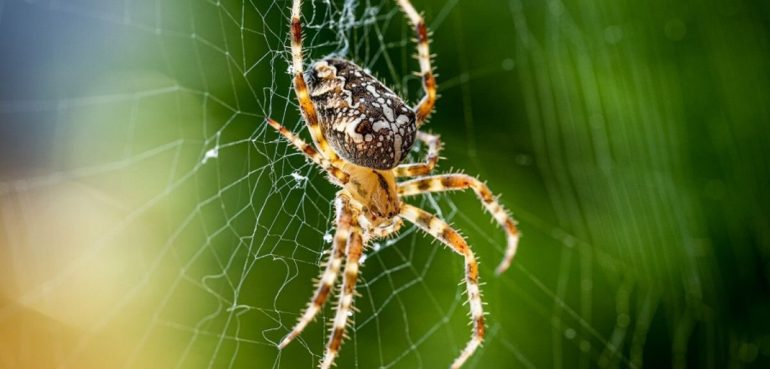Spider webs are engineering marvels constructed by eight-legged experts with 400 million years of accumulated know-how. Much can be learned from the building of the spider’s gossamer net and the operation of its sticky trap. Amazingly, garden cross spiders can regenerate lost legs and use them immediately to build a web that is pitch-perfect, even though the new limb is much shorter than the one it replaced. This phenomenon has allowed scientists to probe the rules the animal uses to build its web and how it uses its legs as measuring sticks.
Studies at the Universities of Oxford and Aarhus have revealed how a spider’s regenerated leg movements fit in with the other legs that are of normal length; coordinating complex movements and thread manipulations.
The study published today by Fritz Vollrath and Thiemo Krink in Interface, a Journal of the Royal Society addresses a key question: each limb acts like a semi-independent computer and does much of the calculations for its positioning locally through adapted sensors, a phenomenon called morphological computing.
This work shows how one can translate the complex sequences of movements and manipulations that the spider uses to construct its web into decision rules that can be tested. Here the behavior is encoded in a set of formal rules embedded in a virtual (or cyber) spider that draws webs on computer screens. By using a combination of experiments with both real and virtual spiders the scientists have been able to probe and verify the rule sets.
The researchers then encoded key parameters of these AI rules as genes and used computer animation in a process called Genetic Algorithm to select virtual webs for their combination of costs and benefits in order to search for optimal solutions.
Professor Fritz Vollrath, from the Oxford Department of Zoology and lead author, said: “We were surprised that an animal was able to ‘do its thing’ perfectly with a leg that is half its normal length and totally new i.e. with muscles that have not exercised and sensors that had no time to ‘learn’ how to respond. It has been exciting to use our novel techniques to unravel an animal’s hidden rules of behavior by combining computer modeling with experimental studies of real animals’ behaviors. Encoding the spider’s decision rules into cyber genes allows us to let the system evolve in a computer based ecosystem by responding to virtual challenges such as cyber flies and imagined cost-benefit balances.”
Vollrath and Krink hope that this understanding will inform aspects of modern Robotics about the ways and means that animals can execute complex tasks using simple rules in combination with adaptable skins and skills.
The algorithms used by their virtual spiders are embedded in applications that can be downloaded. This allows students of all levels to study a spider’s behavior decisions rules online (using web building as a paradigm) and at the same time explore the power of evolution to shape animal behavior and ecology.
The researchers aim to forge deeper links with roboticists to explore how spider behavior can inform unmanned vehicle piloting and navigation, and how novel robots could be constructed and operate.
Tuning the instrument: Spider webs as vibration transmission structures
More information:
Fritz Vollrath et al. Spider webs inspiring soft robotics, Journal of The Royal Society Interface (2020). DOI: 10.1098/rsif.2020.0569
Provided by
University of Oxford
Citation:
Unravelling the secrets of spider limb regeneration to inspire next-gen soft robotics (2020, November 12)
retrieved 13 November 2020
from https://techxplore.com/news/2020-11-unravelling-secrets-spider-limb-regeneration.html
This document is subject to copyright. Apart from any fair dealing for the purpose of private study or research, no
part may be reproduced without the written permission. The content is provided for information purposes only.



